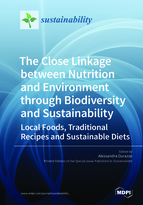The Close Linkage between Nutrition and Environment through Biodiversity and Sustainability: Local Foods, Traditional Recipes and Sustainable Diets
A special issue of Sustainability (ISSN 2071-1050).
Deadline for manuscript submissions: closed (31 October 2018) | Viewed by 86381
Special Issue Editor
Interests: bioactive compounds; natural products; nutraceuticals; antioxidants; dietary supplements; food quality; nutrition; food composition databases; bioavailability, metabolic pathway; nanoformulations
Special Issues, Collections and Topics in MDPI journals
Special Issue Information
Dear Colleagues,
There is a close correlation between the potential benefits and “functional role” of a food and the territory. Nutrition science should support sustainable ecosystems, ecological resources and healthy environments: nutrition and environmental sustainability are strictly linked through the food system.
Appropriate farming based land use, protection of animal health and welfare, environmental conservation as linked to climate knowledge, soil quality and landscaping, lead to the improvement of product quality. The valorization of the typical /local/traditional products by identifying and evaluating food nutritional quality and safety characteristics represents an important goal for the preservation of local agro-biodiversity and supporting sustainable ecosystems and productive system. In this context, it is becoming important to address the consumers towards a sustainable diet and environment-friendly foods and recipes. The determination of the nutritional composition of composite dishes has a key role for defining daily nutrient intakes at the population level and their association with health effects. Specific databases created to promote and preserve the nutritional characteristics of some national traditional foodstuffs are needed. Studies on the nutritional profile and bioactive components of typical foods, own of a territory, as well as traditional recipes are required.
Elucidation and clarification of relationship between the environment and the food quality, as well as evaluation of the influence of agricultural practices, wild species and intra-species biodiversity, environmental factors should be considered.
The overall benefits can be described in terms of increasing the nutritional value of local/traditional foods in the various European countries, ensuring their quality and education of consumers regarding the use of those foods, fitting into a recommended dietary food pattern. The envisaged promotion of traditional products throughout environmentally sustainable techniques further contributes to environmental protection. This strategy should represent a valid tool for promotion of socioeconomic development, enhancement of territories and biodiversity preservation.
All these topics are welcome in this Special Issue.
Dr. Alessandra DurazzoGuest Editor
Manuscript Submission Information
Manuscripts should be submitted online at www.mdpi.com by registering and logging in to this website. Once you are registered, click here to go to the submission form. Manuscripts can be submitted until the deadline. All submissions that pass pre-check are peer-reviewed. Accepted papers will be published continuously in the journal (as soon as accepted) and will be listed together on the special issue website. Research articles, review articles as well as short communications are invited. For planned papers, a title and short abstract (about 100 words) can be sent to the Editorial Office for announcement on this website.
Submitted manuscripts should not have been published previously, nor be under consideration for publication elsewhere (except conference proceedings papers). All manuscripts are thoroughly refereed through a single-blind peer-review process. A guide for authors and other relevant information for submission of manuscripts is available on the Instructions for Authors page. Sustainability is an international peer-reviewed open access semimonthly journal published by MDPI.
Please visit the Instructions for Authors page before submitting a manuscript. The Article Processing Charge (APC) for publication in this open access journal is 2400 CHF (Swiss Francs). Submitted papers should be well formatted and use good English. Authors may use MDPI's English editing service prior to publication or during author revisions.
Keywords
- nutritional composition
- bioactive components
- typical/local foods
- environmental and socio-demographic factors
- traditional recipes
- Food Composition databases
- traditional dietary patterns
- sustainable diets






